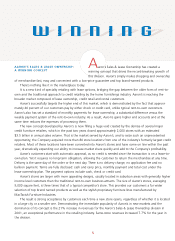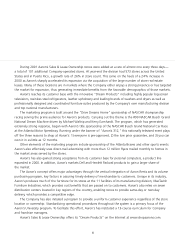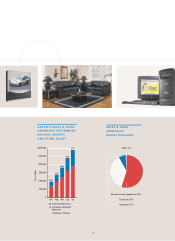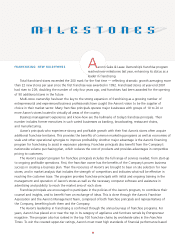Aarons 2001 Annual Report Download - page 18
Download and view the complete annual report
Please find page 18 of the 2001 Aarons annual report below. You can navigate through the pages in the report by either clicking on the pages listed below, or by using the keyword search tool below to find specific information within the annual report.
15
revenues, operating expenses were 45.3% in 2000 and 46.2%
in 1999. Operating expenses decreased as a percentage of total
revenues between years primarily due to increased revenues in
the Aaron’s Sales & Lease Ownership division.
Depreciation of rental merchandise increased $18.3 million
(17.9%) to $120.7 million, from $102.3 million, and as a
percentage of total rentals and fees increased to 33.5% from
32.2% in 1999. The increase as a percentage of rentals and
fees is primarily due to a greater percentage of the Company’s
rentals and fees coming from the Aaron’s Sales & Lease
Ownership division which depreciates its rental merchandise
at a faster rate than the rent-to-rent division.
Interest expense increased $1.5 million (37.0%) to $5.6
million compared to $4.1 million. As a percentage of total
revenues, interest expense was 1.1% in 2000 compared to
.9% in 1999. The increase in interest expense as a percentage
of revenues was due to increased interest rates along with
higher daily average debt levels.
Income tax expense increased $945,000 (6.0%) to $16.6
million compared to $15.7 million. The Company’s effective
tax rate was 37.9% in 2000 compared to 38.0% in 1999.
As a result, net earnings increased $1.7 million (6.5%) to
$27.3 million for 2000 compared to $25.6 million for the same
period in 1999. As a percentage of total revenues, net earnings
were 5.4% in 2000 and 5.9% in 1999. The decrease in net
earnings as a percentage of total revenues is the result of
startup expenses associated with the increased rate at which
the Company opened new Aaron’s Sales & Lease Ownership
stores with 32 stores opened in 2000 compared to 17 in 1999.
LIQUIDITY AND CAPITAL RESOURCES
Cash flows from operations for the years ended December
31, 2001 and 2000 were $189.4 million and $166.2 million,
respectively. Such cash flows include profits on the sale of
rental return merchandise. In 2001, the Company extended
its payment terms with vendors as a source of additional cash
flows. The Company’s primary capital requirements consist
of acquiring rental merchandise for both rent-to-rent and
Company-operated Aaron’s Sales & Lease Ownership stores.
As the Company continues to grow, the need for additional
rental merchandise will continue to be the Company’s major
capital requirement. These capital requirements historically
have been financed through bank credit, cash flow from
operations, trade credit, proceeds from the sale of rental
return merchandise and stock offerings.
The Company has financed its growth through a revolving
credit agreement with several banks, trade credit and internally
generated funds. The revolving credit agreement dated March
30, 2001 provides for unsecured borrowings up to $110.0
million which includes an $8.0 million credit line to fund daily
working capital requirements. The facility expires on March 30,
2004. At December 31, 2001, an aggregate of $72.4 million
was outstanding under this facility, bearing interest at a
weighted average variable rate of 3.2%. The Company uses
interest rate swap agreements as part of its overall long-term
financing program. At December 31, 2001, the Company
had swap agreements with notional principal amounts of $60
million which effectively fixed the interest rates on an equal
amount of the Company’s debt under the revolving credit
agreement at 7.2%. The fair value of interest rate swap
agreements was a liability of approximately $3.1 million at
December 31, 2001.
On October 31, 2001, the Company renewed its $25
million construction and lease facility. From 1996 to 1999,
properties acquired by the lessor were purchased or constructed
and then leased to the Company under operating lease agree-
ments. The total amount advanced and outstanding under this
facility at December 31, 2001 was approximately $24.7 million.
Since the resulting leases are operating leases, no debt obliga-
tion is recorded on the Company’s balance sheet. This con-
struction and lease facility expires in 2006. Lease payments
fluctuate based upon current interest rates and are generally
based upon LIBOR plus 1.35%. The lease facility contains
residual value guarantee and default guarantee provisions.
Although management believes the likelihood of funding to be
remote, the maximum guarantee obligation under the residual
value and default guarantee provisions upon termination is
approximately $20.9 million and $24.7 million, respectively, at
December 31, 2001.
The Company’s revolving credit agreement, the construction
and lease facility, and the franchise loan program discussed
below (collectively “the facilities”) contain financial covenants
which, among other things, require the Company to not
exceed certain debt to equity levels and to maintain a
minimum fixed charge coverage ratio as defined under
the facilities. Failure to maintain these required covenants
would constitute an event of default under the credit facilities,
and all amounts would become due immediately. The Company
was in compliance with all such covenants at December 31,
2001. The Company anticipates it will be in compliance with
such covenants in the future, or will be able to obtain waivers
in the event of non-compliance.
The Company leases warehouse and retail store space
for substantially all of its operations under operating leases
expiring at various times through 2015. Most of the leases
contain renewal options for additional periods periods ranging
from 1 to 15 years or provide for options to purchase the
related property at predetermined purchase prices which do
not represent bargain purchase options. The Company also
leases transportation equipment under operating leases
expiring during the next 3 years. Management expects that
most leases will be renewed or replaced by other leases in the
normal course of business. Future minimum rental payments
required under operating leases that have initial or remaining
non-cancelable terms in excess of one year as of December 31,
2001, are as follows: $30.0 million in 2002; $24.5 million in
2003, $18.8 million in 2004; $12.4 million in 2005; $7.6
million in 2006; and $8.8 million thereafter.
The Company has guaranteed the borrowings of certain
independent franchisees under a franchise loan program with
a bank. In the event these franchisees are unable to meet their
debt service payments or otherwise experience an event of
default, the Company would be unconditionally liable for
the outstanding balance of the franchisee’s debt obligations
($30.6 million as of December 31, 2001), which would be due
in full within 90 days of the event of default. However, due to
franchisee borrowing limits, the Company believes any losses
associated with such a default would be substantially mitigated
through the recovery of rental merchandise and other assets.
The Company has had no significant losses associated with
the franchisee loan and guaranty program.
























